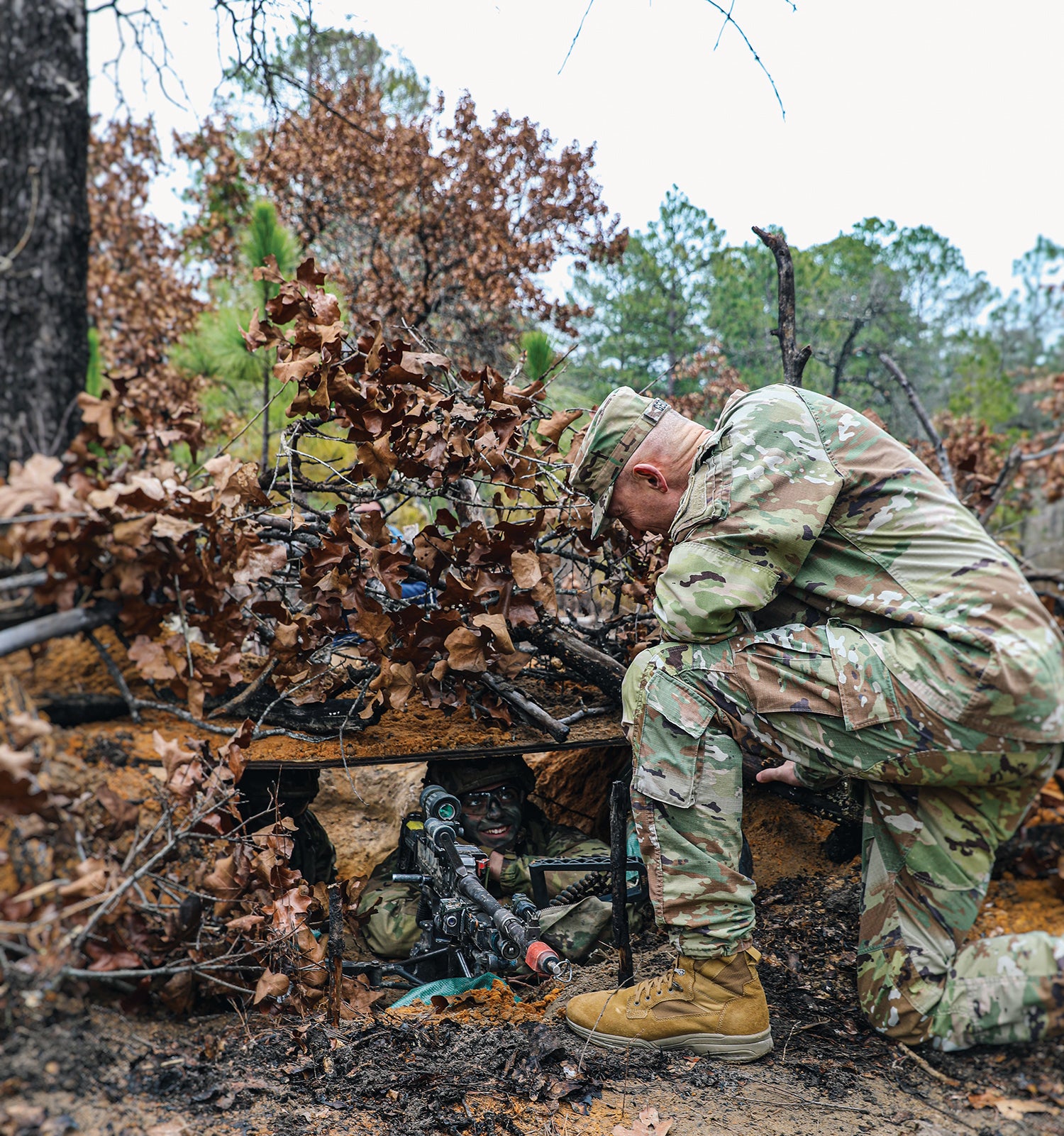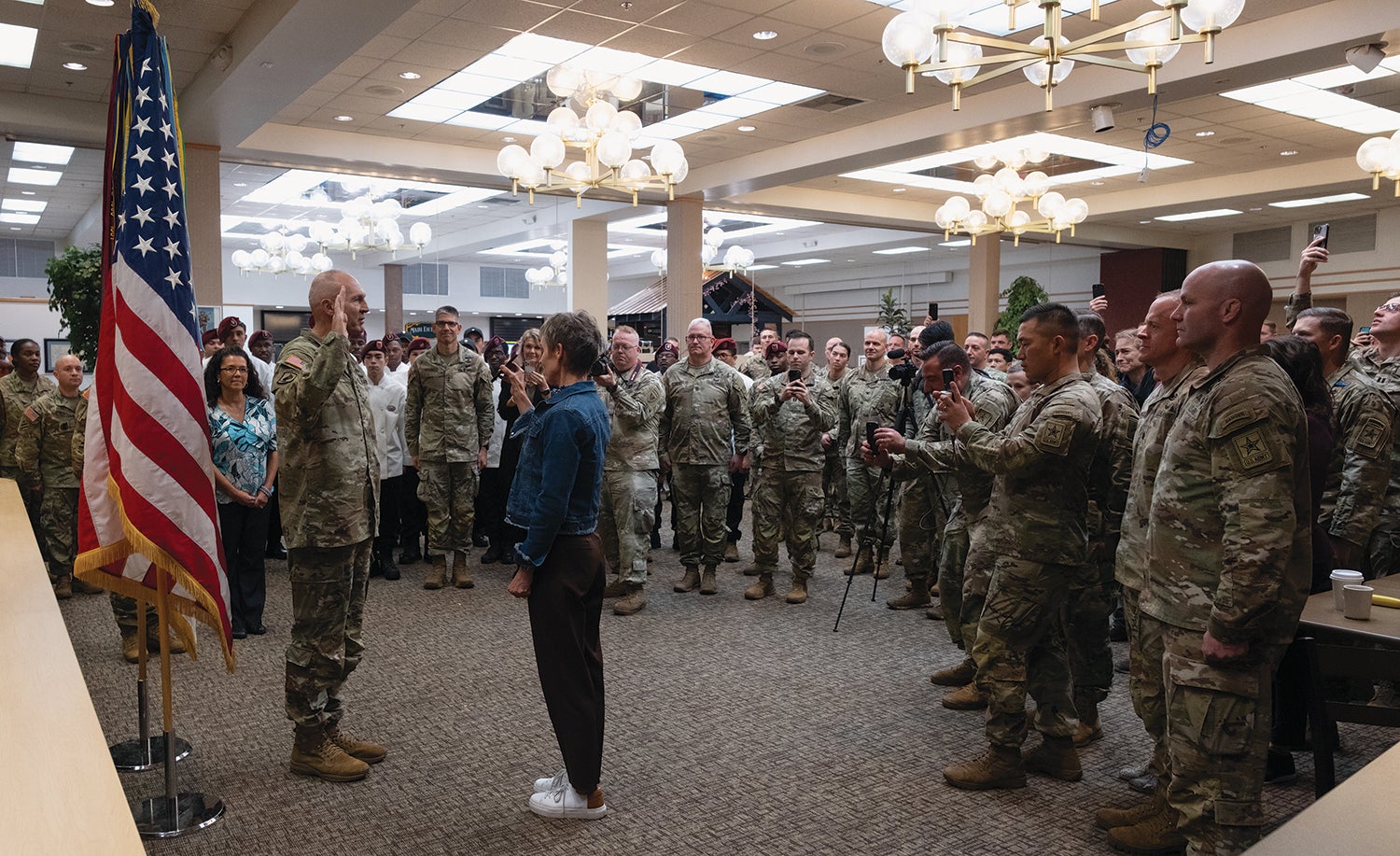While the Army must transform for the future, it also must move with urgency to contend with today’s increasingly volatile and complex world, the service’s top general said.
“The difference today is the tech disruption we’ve had, the volatility is completely different, and just how fast things are spinning on the tech side,” Army Chief of Staff Gen. Randy George said. “I think it’s completely different from what we’ve seen, and there’s a lot of implications with that and how we do business and how we change.”
Since being sworn in last September as the 41st Army chief of staff, George has traveled across the Army and visited soldiers at home station and deployed. In his travels, George said he’s been able to see how soldiers are adapting to the challenges of missions around the world. “I’ve been really getting out there and talking to our troops,” he said. “What we want to do is focus on our warfighting mission and building cohesive teams.”
His time with the troops has reinforced his belief that the Army must focus on warfighting.
“Warfighting. I always tell everybody that that has to be the focus,” George said at a recent event hosted by the Association of the U.S. Army and in an interview afterward. “I want leaders at every level to understand that’s what we’re focused on. If you’re not relaying that message all the way down with what you’re doing, then we need to recalibrate what we’re doing.”
The Army cannot afford to wait, George said. “The environment’s going to change anywhere from three weeks to three months,” he said.

Advancing Technology
A 1988 graduate of the U.S. Military Academy at West Point, New York, George previously was the Army vice chief of staff and is a former commander of I Corps and the 4th Infantry Division. A veteran of the wars in Iraq and Afghanistan, George said today’s Army faces a different battlefield.
In the past, the Army built itself to “deploy [brigade combat teams] back and forth to Iraq and Afghanistan,” George said. “We have to adjust to the contemporary battlefield, and we’re doing that.”
In the next fight, soldiers likely will operate in small groups dispersed across large areas. There will be sensors everywhere, making it nearly impossible to hide. Increasingly sophisticated cyberattacks and electronic warfare will threaten communications, and drones will be an ever-growing threat.
The war in Ukraine is an example, George has said. “On the battlefield today, everything is a sensor,” he said. “I recall when satellite technology brought news from the battlefield to Americans’ living rooms. That in and of itself gave a new dynamic to war-fighting.”


‘No One Can Hide’
Now, everyone has better cameras in their pockets, and they’re connected to the cloud, George said. “No one can hide, and no formation is safe,” he said. “Where we can see, we can hit, and we can see everywhere.”
Additionally, logistics are more complex, particularly long logistics tails that can easily be hit or sabotaged, and autonomous systems are a growing challenge, George said.
To meet some of these challenges, the Army must prioritize the network, which is one of the service’s top transformation priorities, and look for ways to incorporate unmanned aircraft systems, robotics, 3D printing and other emerging technologies to bolster the force.
It also means minimizing units’ footprints—digital and physical—on the battlefield.
“The network has to be the No. 1 priority,” George said. “You cannot communicate, you cannot command and control; everything we do across our warfighting functions depends on our network.”
In addition to building a reliable, secure network, the Army must have a network that’s mobile and agile. “When you’re on the battlefield, you don’t want to be seen; you want to blend into the environment,” George said.
The sprawling command posts on forward operating bases in Iraq and Afghanistan will no longer work, George said. “That will get us killed on today’s battlefield,” he said.

Reduced Footprints
During a visit earlier this year to the National Training Center at Fort Irwin, California, George said he observed as the 1st Armored Division’s tactical command post was “five vehicles” protected by a radio frequency shield and a small unmanned aircraft system, and a command-and-control node “that could be moved in five minutes.” The III Corps command post was hidden in a warehouse with no vehicles parked outside.
“That’s what we need,” George said. “It was very low-signature.”
To further experiment with reducing a unit’s digital footprint while maximizing technologies such as robotics and unmanned aircraft systems, the Army is selecting some deploying brigades for what George calls “transforming in contact.”
The goal is to adjust these formations for what the mission may demand. As an example, George said, a unit may get more unmanned aircraft systems and electronic warfare capabilities. Another may get more robotics or the first batch of Next-Generation Squad Weapons. They then will train with these new capabilities and provide feedback on what’s working and what’s not.
“We have things in our formation that need to adjust and need to change,” George said. “Based on what we’re seeing with the lessons on the battlefield, this is going to give us an opportunity to do that.”

New Capabilities
One of the units tapped for this is the 2nd Brigade Combat Team, 101st Airborne Division (Air Assault), George said. The brigade, which in January completed a rotation at the Joint Readiness Training Center at Fort Johnson, Louisiana, formerly known as Fort Polk, will get small unmanned aerial vehicles and the new Next-Generation Squad Weapons, George said.
The Army also is going to “adjust their network” and look at how it can “add to their formation with robotics,” George said.
The soldiers will train with the new equipment and capabilities, then return to the Joint Readiness Training Center, he said. “They’re looking at how can they make their formation more lethal and adjust their formation to today’s realities on the battlefield,” George said.
Feedback from the soldiers, as well as those from other units chosen to participate in this effort, will be used to inform additional changes throughout the force. “This will inform how the Army needs to adapt going forward,” George said.
Several units will begin this process “over the next couple of months,” George said.
Soldiers from the 2nd Brigade Combat Team, 101st Airborne Division, already are adapting and learning, George said. “Those soldiers are so innovative,” he said. “They’re adjusting and learning over there, and that’s what we need to do.”
Another area the Army is examining is its light or medium brigade combat teams, George said. “What we know is we need to be more strategically mobile,” he said. “My example is, we have a light formation that has way too many vehicles, which are targets on the battlefield, so there are things we need to do to adjust.”

Drone Wars
The way the Army conducts reconnaissance also will change with the advent of unmanned aircraft systems, he said. These systems continue to be a challenge, and “it’s a reality of today’s battlefield,” George said. A particular challenge is countering these systems.
“I think we have to do more,” George said. He added that the Army is putting users, developers and testers together in the Middle East to come up with solutions.
“I was over in the Middle East, and standing there on the roof of a building, whether it was up in Irbil [in Iraq] or in Syria at a small outpost, you understand how different those environments are and what we need to do to increase our capability,” he said. “It’s moving, it’s adjusting rapidly, so what we want to do is be forward and actually have everybody on the ground start adjusting.”
Robotics are another element of the future battlefield, and the Army must look for ways to leverage the growing capability, George said. “If you can put a robot in contact and save lives to do that—breaching is a good example of that—then we should be looking at ways to do it.”
George said he also is focused on how the Army can “unencumber” commanders and soldiers, such as getting rid of excess equipment, so they can focus on the important tasks.
Last fall, George cited as an example a company commander in Europe whose property book was 118 pages. “That makes no sense,” George said then. “We will take that off commanders’ plates and off soldiers’ plates. They shouldn’t be spending time caring for equipment they don’t need.”
A pilot program from October through December at Fort Liberty, North Carolina, formerly known as Fort Bragg, and Fort Stewart, Georgia, yielded 37,068 pieces of excess equipment, freeing up commanders from having to account for obsolete or excess equipment. The pilot was run at Fort Campbell, Kentucky, in February, and it will take place at Joint Base Lewis-McChord, Washington, in June, with other installations planned for later in the year, George said.
“It’s a really busy Army. We have to make some adjustments,” George said. “There’s a sense of urgency to what we’re doing.”

Agility, Flexibility
As the Army transforms, it must be agile and flexible when it comes to adopting new technology, George said. “We’re going to have to be much more rapid in our systems,” he said.
And any system the Army gets must be simple and intuitive for the soldiers operating them, George said. “They have to be able to be operated by one or two people, very simply.”
He added, “Anything that’s on the battlefield that can’t move quickly is not going to survive. We’ve got to look at things that are mobile, can get shots off rapidly and very accurately.”
The Army also must partner with industry, he said, particularly in emerging areas such as unmanned aircraft systems and data. “Wherever we can, I think we really need to leverage the power of American industry to help us figure this out,” he said.
The service also must apply what it’s learning at its schoolhouses. “We want to see, out of the lessons that we’re learning, what are we doing to change our training?” George said. “What are we doing to change our professional education? What are we doing to change the equipment we need on the modern battlefield?”
George said he tells leaders that everybody has a job to do at every level of the Army, and the service must do everything it can to make sure soldiers have the right leaders, equipment and training they need when they go into harm’s way. “We can’t forget that, regardless of how far you get from the front line,” he said. “That’s our mission, and we need to keep that at the forefront.”

